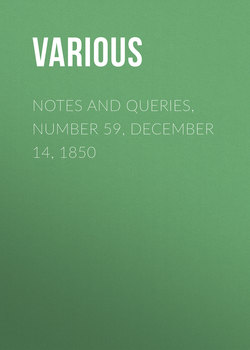Читать книгу Notes and Queries, Number 59, December 14, 1850 - Various - Страница 4
NOTES
MINOR NOTES
ОглавлениеCirculation of the Blood.—About twenty-five years since, being in a public library in France, a learned physician pointed out to me in the works of the Venerable Bede a passage in which the fact of the circulation of the blood appeared to him and myself to be clearly stated. I regret that I did not, at the time, "make a note of it," and that I cannot now refer to it, not having access to a copy of Bede: and I now mention it in hopes that some of your correspondents may think it worth while to make it a subject of research.
J. MN.
Culprit, Origin of the Word.—Long ago I made this note, that this much used English word was of French extraction, and that it was "qu'il paruit," from the short way the clerk of the court has of pronouncing his words; for our pleadings were formerly in French, and when the pleadings were begun, he said to the defendant "qu'il parait"—culprit; and as he was generally culpable, the "qu'il parait" became a synonyme with offender.
T.
Cambridge.
[Does not our ingenious correspondent point at the more correct origin of culprit, when he speaks of the defendant being "generally culpable?"]
Collar of SS.—In the volume of Bury Wills just issued by the Camden Society, is an engraving from the decorations of the chantry chapel in St. Mary's Church, Bury St. Edmund's, of John Baret, who died in 146-; in which the collar is represented as SS in the upright form set on a collar of leather or other material. It is described in the will as "my collar of the king's livery." John Baret, says the editor of the Wills, was a lay officer of the monastery of St. Edmund, probably treasurer, and was deputed to attend Henry VI. on the occasion of the king's long visit to that famed monastic establishment in 14—.
BURIENSIS.
The Singing of Swans.—"It would," says Bishop Percy (Mallet's North. Antiq., ii. p. 72.), "be a curious subject of disquisition, to inquire what could have given rise to so arbitrary and groundless a notion as the singing of swans," which "hath not wanted assertors from almost every nation." (Sir T. Browne.)
"Not in more swelling whiteness sails
Cayster's swan to western gales, 3
When the melodious murmur sings
'Mid her slow-heav'd voluptuous wings."
T.J.
Sir Thomas Herbert's Memoirs.—In consequence of the suggestion of Δ. (Vol. ii., p. 220.), I have applied to the owner of Sir T. Herbert's MS. account of the last days of Charles I., and the answer which I have received is as follows:
"I found the first part of Sir Thos. Herbert's MS. (56 pages) is not in the edition of Woods Athenæ Lord W. has; but I found a note in a pedigree book, saying it was printed in 1702, 8vo. I suppose it can be ascertained whether this is true."
Perhaps some of your readers may know whether there is such a volume in existence as that described by my friend.
ALFRED GATTY.
Portraits of Stevens and Cotton and Bunyan.—The plan of "NOTES AND QUERIES" appears well adapted to record the change of hands into which portraits of literary men may pass. I accordingly offer two to your notice.
The portrait of George Stevens, the celebrated annotator on Shakspeare, who died in 1800, was bequeathed by him to a relative, Mrs. Gomm of Spital Square; and at that lady's death, some years after, it passed, I have reason to expect, into the possession of her relative, Mr. Fince, of Bishopsgate Street. I have no farther information of it.
The portrait of Charles Cotton, by Sir Peter Lely, was, at the time (1814) when Linnell took a copy, and (in 1836) when Humphreys took a copy, in the possession of John Berisford, Esq., of Compton House, Ashborne, Derbyshire; and the following extracts of letters will show who at present possesses it:—
"Leek, 14th July, 1842.
"After Mr. Berisford's decease, I should think the portrait of Cotton would fall into the hands of his nephew Francis Wright, Esq., of Linton Hall, near Nottingham.
I am, &c. &c"
"Linton Hall, Aug. 19. 1842.
"Sir,—The Rev. J. Martin, of Trinity College, Cambridge, is the possessor of the portrait of Cotton to which your letter alludes. I am, Dear Sir,
"Yours, in haste,
"F. WRIGHT."
I avail myself of the present opportunity to ask the authority for the portrait of Bunyan appended to his ever-fresh allegory. The engraved portrait I have has not the name of the painter.
O.W.
Sonnet: Attempting to prove that Black is White.—
That white was really black, and black was white;
But I believe it has not yet been done.
Black (Saxon, Blac) in any way to liken
With candour may seem almost out of reach;
Yet whiten is in kindred German bleichen,
Undoubtedly identical with bleach:
This last verb's cognate adjective is bleak—
Reverting to the Saxon, bleak is blæk.*
A semivowel is, at the last squeak,
All that remains such difference wide to make—
The hostile terms of keen antithesis
Brought to an E plus ultra all but kiss!"
MEZZOTINTO.
Nicholas Breton's Fantasticks, 1626.—MR. HEBER says, "Who has seen another copy?" In Tanner's Collection in the Bodleian Library is one copy, and in the British Museum is another, the latter from Mr. Bright's Collection.
W.P.
[Another copy is in the valuable collection of the Rev. T. Corser. See that gentleman's communication on Nicholas Breton, in our First Vol., p. 409.]
3
"It was an ancient notion that the music of the swan was produced by its wings, and inspired by the zephyr. See this subject, treated with his accustomed erudition, by Mr. Jodrell, in his Illustrations of the Ion of Euripides."—Bulwer's Siamese Twins.
4
Pronounced (as black was anciently written) blake.
